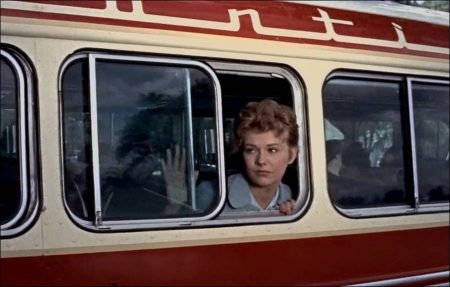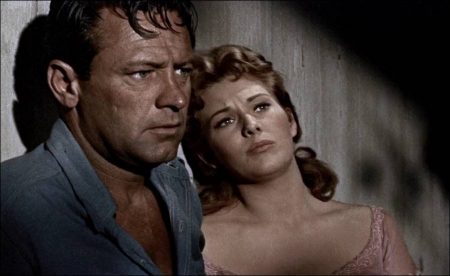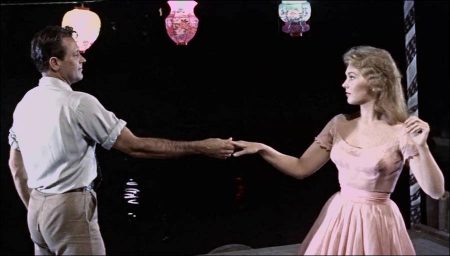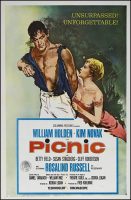Picnic movie synopsis. The drifter Hal Carter hitchhikes by train to a small town to visit the college friend Alan Benson, who is the son of the industrialist Mr. Benson that is the wealthiest person in town. Hal asks for a small job to Ms. Helen Potts and the old lady feels affection for him and tells that nobody works in the Labor Day. She gives a breakfast to Hal and he meets her next door neighbor, the gorgeous Marjorie “Madge” Owens that is Alan’s girlfriend.
Then Hal is welcomed by Alan that invites him to go to the local picnic with Madge’s younger sister Millie Owens. Hal is a braggart, but attractive and gentle, and he becomes successful with the local girls. However, he falls in love with Madge and Alan feels betrayed by his best friend.
Picnic is a 1955 American Technicolor romantic comedy-drama film filmed in Cinemascope. It was adapted for the screen by Daniel Taradash from William Inge’s 1953 Pulitzer Prize-winning play of the same name. Joshua Logan, director of the original Broadway stage production, directed the film version, which stars William Holden, Kim Novak, and Rosalind Russell, with Susan Strasberg and Cliff Robertson in supporting roles. Picnic was nominated for six Academy Awards, including Best Picture, and won two.
The film dramatizes 24 hours in the life of a small Kansas town in the mid-20th century. It revolves around the Labor Day holiday. It is the story of an outsider whose appearance disrupts and rearranges the lives of those with whom he comes into contact.
Filming Locations
The extensive use of Kansas locations highlighted the naturalistic, small-town drama. Picnic was shot mostly around Hutchinson, Kansas. Other Kansas locations include:
Halstead’s Riverside Park is where the Labor Day picnic scenes were filmed. The park and many landmarks remained at the time of the movie’s 50th anniversary. The merry-go-round and cable suspension footbridge, which spans the Little Arkansas River, are still located there.
Nickerson is the location of the two adjacent houses used for the Owens family home and that of Mrs. Potts. It is where Hal (William Holden) “jumps a freight” to go to Tulsa and where Madge boards a bus in the last scene.
Salina, for the opening scene where Hal jumps off a train, then meets Alan (Cliff Robertson) at Alan’s father’s large house. This location is also used for the Saline River (where Madge kisses Hal) and the scene where Hal escapes from the police by running under a waterfall.
Sterling, where the pre-picnic swim in the lake was filmed.

About the Story
Hal Carter (William Holden) is a former college football star, adrift and unemployed after army service and a failed acting career in Hollywood. On Labor Day (September 5, 1955), he arrives by freight train in a Kansas town to visit his fraternity friend Alan Benson (Cliff Robertson). Working for his breakfast by doing chores in the backyard of kindly Mrs. Potts (Verna Felton), Hal meets Madge Owens (Kim Novak), her sister Millie (Susan Strasberg), and their mother (Betty Field).
Hal tries to be accepted and gets along with most. Alan is very happy to see the “same old Hal”, whom he takes to his family’s sprawling grain elevator operations. Alan promises Hal a steady job as a “wheat scooper” (though Hal had unrealistic expectations of becoming an executive) and invites Hal to swim and to attend the town’s Labor Day picnic. Hal is wary about going to the picnic, but Alan nudges him into it, saying Hal’s “date” will be Millie, who is quickly drawn to Hal’s cheerful demeanor and charisma. Alan reassures Mrs. Owens that although Hal flunked out of college, there are no reasons to be concerned about him.
The afternoon carries on happily, until Hal starts talking about himself too much, and Alan stops him with cutting remarks. It’s obvious that Hal and Madge like each other. When the sun sets, everyone wanders off. Millie draws a sketch of Hal and tells him she secretly writes poetry, growing fond of him despite his lack of interest. Madge is named the town’s annual Queen of Neewollah (“Halloween” spelled backward), and Hal longingly gazes at her while she is brought down the river in a swan-shaped paddle-boat. They shyly say “Hi” to each other as she glides by.
Middle-aged schoolteacher Rosemary (Rosalind Russell), who rents a room at the Owens house, has been brought to the picnic by store owner Howard Bevens (Arthur O’Connell); both had been drinking whiskey. When the band plays dance music, Howard says he can’t dance, so Rosemary dances with Millie. Hal and Howard then start dancing together, which angers Rosemary; she grabs Howard, who then dances with her.
Hal tries to show Millie a dance he learned in LA to the song, Moonglow, but Millie cannot quite get the beat. Madge stumbles upon them, seductively transforming the moves Hal is showing Millie, and sways toward him, thus initiating a dance with him in which they both become increasingly mesmerized. Millie, having been cast aside and ignored by both Rosemary and Hal, sulks off and starts drinking Howard’s whiskey. Rosemary, now quite drunk, jealously breaks up the dance between Madge and Hal. Rosemary flings herself at Hal, saying he reminds her of a Roman gladiator.
When Hal tries to ward off the schoolteacher, she rips his shirt, then bitterly calls him a bum. Mrs. Owens and Alan arrive and believe Hal has caused a scandal, made all the worse when Millie breaks down, screaming, “Madge is the pretty one!” and becomes ill from the whiskey. Rosemary, blinded by her anger, tells Mrs. Owens that Hal gave Millie the whiskey, while Howard’s plea that he brought the whiskey seems to fall on deaf ears. Alan blames Hal for the mess and says he is ashamed that he brought Hal in the first place. By now a crowd is watching, and Hal flees into the darkness.
Picnic (1956)
Directed by: Joshua Logan
Starring: William Holden, Kim Novak, Betty Field, Rosalind Russell, Cliff Robertson, Susan Strasberg, Verna Felton, Reta Shaw, Nick Adams, aymond Bailey, Elizabeth Wilson, Arthur O’Connell
Screenplay by: Daniel Taradash
Production Design by: Jo Mielziner
Cinematography by: James Wong Howe
Film Editing by: William A. Lyon, Charles Nelson
Costume Design by: Jean Louis
Set Decoration by: Robert Priestley
Makeup Department: Clay Campbell, Helen Hunt, Robert J. Schiffer
Music by: George Duning
MPAA Rating: None.
Distributed by: Columbia Pictures
Release Date: February 16, 1956 (USA)
Views: 467


